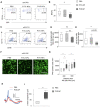Circulating inflammatory monocytes oppose microglia and contribute to cone cell death in retinitis pigmentosa
- PMID: 35529318
- PMCID: PMC9075747
- DOI: 10.1093/pnasnexus/pgac003
Circulating inflammatory monocytes oppose microglia and contribute to cone cell death in retinitis pigmentosa
Abstract
Retinitis pigmentosa (RP) is an intractable inherited disease that primarily affects the rods through gene mutations followed by secondary cone degeneration. This cone-related dysfunction can lead to impairment of daily life activities, and ultimately blindness in patients with RP. Paradoxically, microglial neuroinflammation contributes to both protection against and progression of RP, but it is unclear which population(s) - tissue-resident microglia and/or peripheral monocyte-derived macrophages (mφ) - are implicated in the progression of the disease. Here we show that circulating blood inflammatory monocytes (IMo) are key effector cells that mediate cone cell death in RP. Attenuation of IMo and peripherally engrafted mφ by Ccl2 deficiency or immune modulation via intravenous nano-particle treatment suppressed cone cell death in rd10 mice, an animal model of RP. In contrast, the depletion of resident microglia by a colony-stimulating factor 1 receptor inhibitor exacerbated cone cell death in the same model. In human patients with RP, IMo was increased and correlated with disease progression. These results suggest that peripheral IMo is a potential target to delay cone cell death and prevent blindness in RP.
Keywords: Nanomedicine; Neuroinflammation; Peripheral monocyte.
Conflict of interest statement
Conflict of interest statement: The authors have declared that no conflict of interest exists.
Figures






Similar articles
-
Suppression of microglial activation is neuroprotective in a mouse model of human retinitis pigmentosa.J Neurosci. 2014 Jun 11;34(24):8139-50. doi: 10.1523/JNEUROSCI.5200-13.2014. J Neurosci. 2014. PMID: 24920619 Free PMC article.
-
A review of the mechanisms of cone degeneration in retinitis pigmentosa.Acta Ophthalmol. 2016 Dec;94(8):748-754. doi: 10.1111/aos.13141. Epub 2016 Jun 27. Acta Ophthalmol. 2016. PMID: 27350263 Review.
-
Antioxidants slow photoreceptor cell death in mouse models of retinitis pigmentosa.J Cell Physiol. 2007 Dec;213(3):809-15. doi: 10.1002/jcp.21152. J Cell Physiol. 2007. PMID: 17520694
-
Necrotic enlargement of cone photoreceptor cells and the release of high-mobility group box-1 in retinitis pigmentosa.Cell Death Discov. 2015 Nov 30;1:15058. doi: 10.1038/cddiscovery.2015.58. eCollection 2015. Cell Death Discov. 2015. PMID: 27551484 Free PMC article.
-
Metabolic rescue of cone photoreceptors in retinitis pigmentosa.Taiwan J Ophthalmol. 2021 Dec 6;11(4):331-335. doi: 10.4103/tjo.tjo_46_21. eCollection 2021 Oct-Dec. Taiwan J Ophthalmol. 2021. PMID: 35070660 Free PMC article. Review.
Cited by
-
Ocular and Serum Profiles of Inflammatory Molecules Associated With Retinitis Pigmentosa.Transl Vis Sci Technol. 2024 Aug 1;13(8):18. doi: 10.1167/tvst.13.8.18. Transl Vis Sci Technol. 2024. PMID: 39120884 Free PMC article.
-
Purinergic Receptors P2X7 and P2X4 as Markers of Disease Progression in the rd10 Mouse Model of Inherited Retinal Dystrophy.Int J Mol Sci. 2022 Nov 25;23(23):14758. doi: 10.3390/ijms232314758. Int J Mol Sci. 2022. PMID: 36499084 Free PMC article.
-
The double-edged sword of inflammation in inherited retinal degenerations: Clinical and preclinical evidence for mechanistically and prognostically impactful but treatable complications.Front Cell Dev Biol. 2023 Apr 13;11:1177711. doi: 10.3389/fcell.2023.1177711. eCollection 2023. Front Cell Dev Biol. 2023. PMID: 37123408 Free PMC article.
-
Dual-targeting CSF1R signaling attenuates neurotoxic myeloid activation and preserves photoreceptors in retinitis pigmentosa.J Neuroinflammation. 2025 Jul 26;22(1):193. doi: 10.1186/s12974-025-03525-0. J Neuroinflammation. 2025. PMID: 40713818 Free PMC article.
-
A 69 kb Deletion in chr19q13.42 including PRPF31 Gene in a Chinese Family Affected with Autosomal Dominant Retinitis Pigmentosa.J Clin Med. 2022 Nov 11;11(22):6682. doi: 10.3390/jcm11226682. J Clin Med. 2022. PMID: 36431159 Free PMC article.
References
Grants and funding
LinkOut - more resources
Full Text Sources
Research Materials

